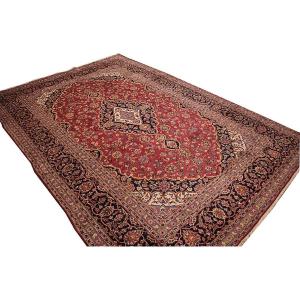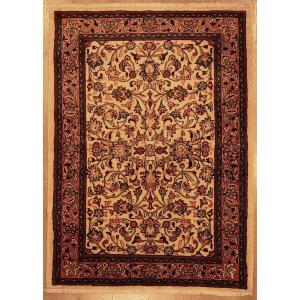The borders have been restored as well as the stop stitches (French restoration) a few years ago. Solid and durable carpet. Fine and careful work. Beautifully made.
Located 40 km north of Sultanabad (Arak region, western Iran), the ancient village of Sarouk (or Sarough) was already known in the 14th century. The carpets of Sarouk and its surroundings were made in an ancient tradition in small workshops. From the middle of the 19th century, production developed at the request of European companies. These carpets were intended for the European market and from the 20th century, for the American market ('American Sarouk') where they were held in high esteem. Before 1913, the patterns were made from memory. Later, George Stevens asked that the patterns be drawn on 'cartons'* before the carpets were made. Before 1915, the Sarouk pile was short. Later, the pile was thicker because it was more appreciated by American demand.
Elegant Sarouk in mian farsh format, featuring a floral theme on a patinated pink background called 'dughi'. This particular color was obtained from natural dyes: vine leaves with the addition of madder. Alum and lactic acid were added to the bath. The flower vases are richly worked, inserting botehs** for some. Six small borders with the 'herati' or 'samovari' (flowers) motif frame a superb border on a navy blue background.
*Carton: Carpet diagram. This is a design composed of small colored squares, each corresponding to a knot. The Ustad is the master who makes the cartons.
**Boteh: Ancient motif with different meanings. It can represent the transformation of Zoroaster into a cypress, symbol of eternity, but also into a drop of water, a palm, a tree. The term boteh means "flowering bush" in Persian. There is a similarity with yin and yang.
Free Chronopost delivery for France and Europe. Do not hesitate to contact us by phone or email. (We ship our rugs and kilims by Chronopost or Colissimo, at our expense (up to 30 kg) in mainland France and Europe).

























 Le Magazine de PROANTIC
Le Magazine de PROANTIC TRÉSORS Magazine
TRÉSORS Magazine Rivista Artiquariato
Rivista Artiquariato
